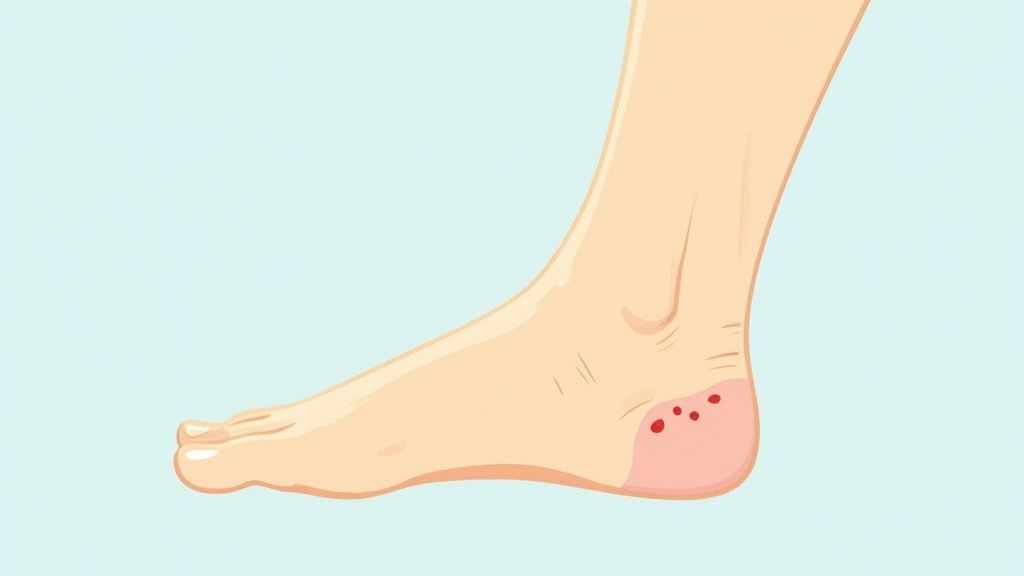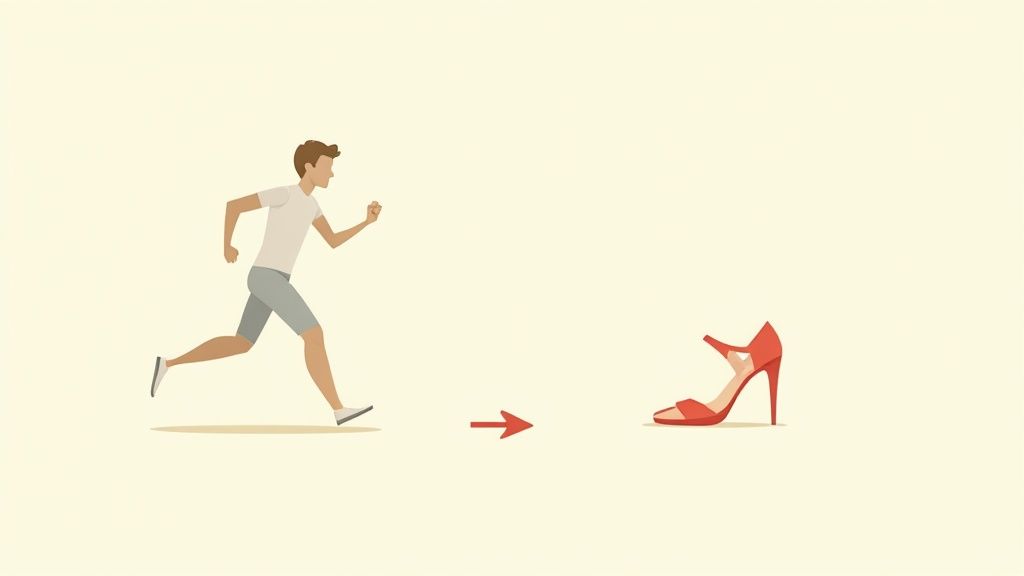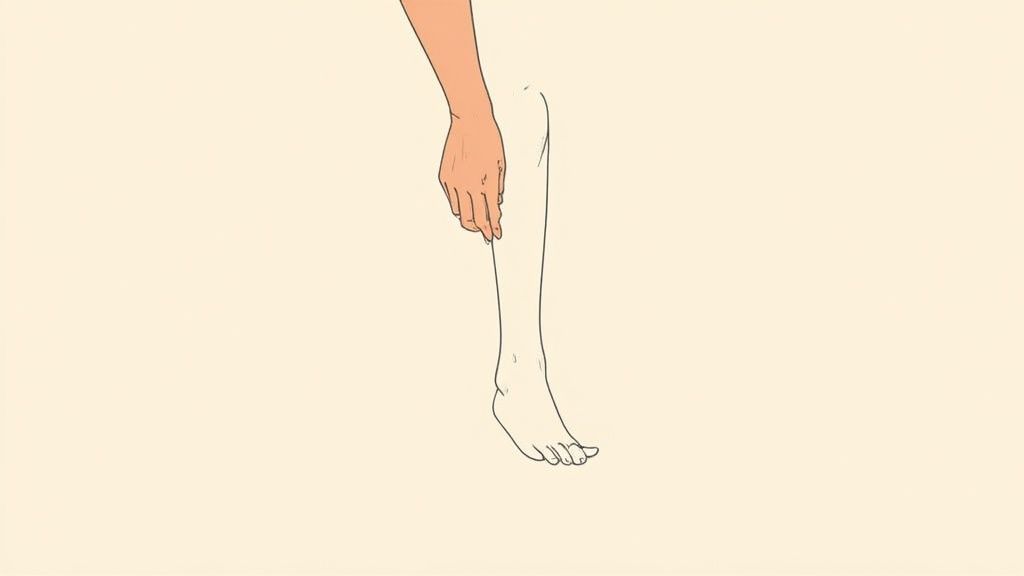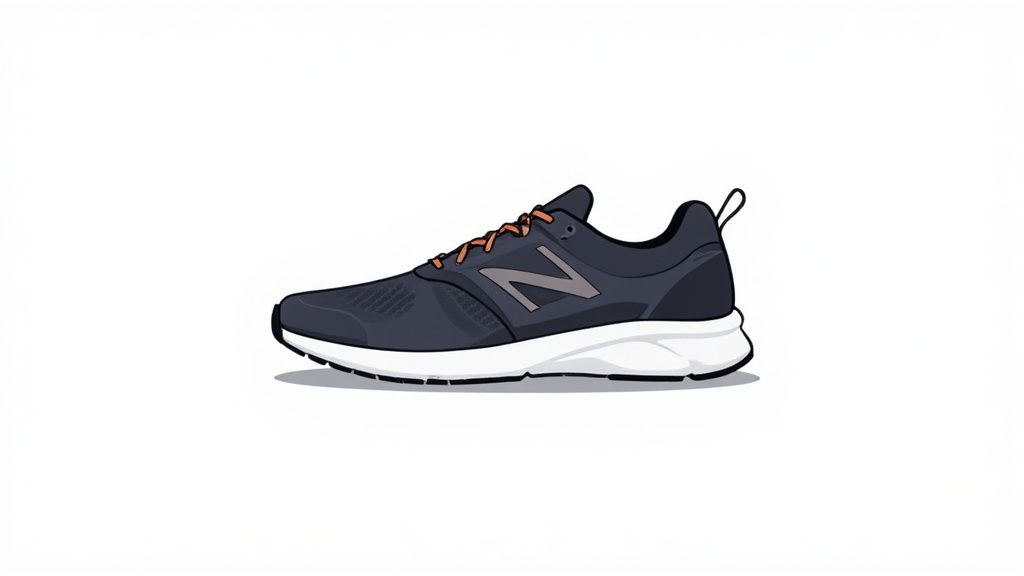If you’re wondering, “Where is plantar fasciitis pain actually located?” you're probably already familiar with that sharp, stabbing feeling in your foot, especially when you first get out of bed.
Most people feel it right under the heel. But the pain isn’t always confined to one spot; it can also stretch into the arch, turning simple movements into a painful ordeal.
Pinpointing Your Plantar Fasciitis Pain
Think of your plantar fascia as a thick, powerful bowstring that runs along the bottom of your foot, supporting your arch. When this band gets overstressed and irritated, tiny tears can develop, causing inflammation and pain right where it connects to your heel bone. That’s the classic sign of plantar fasciitis.
It's a surprisingly common problem, impacting about 10% of people at some point in their lives.
Where you feel the pain is a huge clue. While a sore heel is the textbook symptom, knowing the different hotspots can help you figure out if what you're experiencing is truly plantar fasciitis.
The 2 Main Pain Hotspots
The pain doesn't just show up randomly. It tends to follow the path of the plantar fascia itself, concentrating in a couple of key areas.
- Right Under the Heel: This is the most frequent spot. You'll notice a sharp, tender pain on the bottom of your heel, often a little toward the inside edge. This is where the fascia anchors to the heel bone.
- Through the Arch: Sometimes the pain feels more like a tight, pulling sensation that radiates from your heel forward into the arch. It can feel like a rope being stretched too tight.
The timing of the pain is just as important as the location. A hallmark of plantar fasciitis is intense pain after periods of rest—like those first few steps in the morning or after standing up from your desk. It often eases into a dull ache as you get moving.
To get an even more detailed breakdown, you can find out the exact location of plantar fasciitis pain and see how your symptoms match up.
Quick Guide to Plantar Fasciitis Pain Hotspots
This simple table can help you quickly identify the pain you're feeling. By matching your symptoms to these common patterns, you can get a clearer picture of what's going on with your feet.
| Pain Location | Type of Sensation | When It Hurts Most |
|---|---|---|
| Center of the Heel | Sharp, stabbing, or bruise-like | First steps in the morning or after resting |
| Arch of the Foot | Tight, pulling, or aching | During or after long periods of standing/walking |
| Inner Edge of Heel | Tender and localized | When pressing on the area or after activity |
Understanding these hotspots is the first step. Once you know where the pain is coming from, you're in a much better position to find effective relief.
The Classic Sign: A Heel Pain Hotspot
When someone asks, “Where does plantar fasciitis hurt the most?” the answer is almost always the same. It’s that sharp, tender spot right under the heel bone. This isn't just some random ache; it's the specific bullseye for this condition.

Think of your plantar fascia as a thick, powerful band that connects your heel to the front of your foot, acting like a shock absorber. Every step you take puts tension on this band, especially at the point where it anchors into your heel bone (the calcaneus). Over time, this constant pulling can cause tiny tears and inflammation right at that insertion point, leading to that all-too-familiar pain.
This issue is especially common as we get a bit older. For adults between 40 and 60, plantar fasciitis makes up about 15% of all foot problems they deal with. While the main event is that stabbing heel pain, it’s not unusual for a dull ache to radiate forward into the arch as well.
Why That First Step of the Day Is a Killer
One of the biggest clues you're dealing with plantar fasciitis is the dreaded "first-step pain." You swing your legs out of bed, put your foot down, and—bam—a sharp, piercing sensation shoots through your heel. It’s enough to make you wince.
So, what's happening? Overnight, as you rest, your plantar fascia tightens up and shortens. That first step in the morning suddenly and forcefully stretches this cold, contracted tissue. The abrupt pull on the already inflamed area is what causes that intense, localized jolt of pain.
The Morning Agony Explained: It’s like trying to stretch a cold, stiff rubber band. If you yank it quickly, it’s rigid and unforgiving. But if you warm it up and gently lengthen it, it becomes pliable. Your plantar fascia works in much the same way.
After you've walked around for a few minutes, the tissue starts to warm up and loosen. This is why that initial sharp pain often fades into a more persistent, dull ache. Recognizing this classic pattern is half the battle, but learning how to fix plantar fasciitis means adopting a strategy that actively reduces that daily strain.
When Heel Pain Radiates into Your Arch
Even though the classic sign of plantar fasciitis is a sharp pain right in the heel, it rarely stays put. It's incredibly common for that stabbing sensation to travel forward, creating a deep, pulling ache that stretches through the entire arch of your foot. To really understand where plantar fasciitis can hurt, you have to look beyond just the heel.

Picture your plantar fascia like a tough, fibrous hammock slung underneath your foot, connecting your heel bone to the balls of your toes. Its main purpose is to hold up your arch. When the main anchor point at the heel gets irritated and inflamed, the whole hammock pulls taut. That tension is what you feel as arch pain.
This radiating feeling is one of the classic clues that separates true plantar fasciitis from just a tired, sore foot.
Is It Arch Strain or Plantar Fasciitis?
It's easy to get these two mixed up, but they feel quite different. A general arch strain usually feels like a vague, dull soreness spread across the bottom of your foot, especially after a long day of standing. The arch pain from plantar fasciitis, on the other hand, is much more specific and feels directly connected to your heel.
A tell-tale sign of plantar fasciitis arch pain is a distinct, tight, string-like sensation. If you press along your arch, you can often feel a taut, tender band that traces a clear path right from your heel.
Recognizing this pattern is a huge step in understanding what’s really going on. The pain isn't in two separate spots; it’s one interconnected problem. The inflammation that starts in the heel sets off a chain reaction, making the entire plantar fascia ligament rigid and painful.
Once you can pinpoint this radiating pain, you can describe your symptoms more clearly and be confident you’re on the right path to finding relief.
Decoding Your Daily Pain Patterns
If you're trying to figure out if your foot pain is plantar fasciitis, paying close attention to when it hurts is one of the biggest clues you have. This condition has a very distinct rhythm, a daily cycle that’s often quite different from other foot problems. It can feel a little backward at first, but once you understand the pattern, it makes perfect sense.

The classic giveaway? That excruciating pain with your very first steps in the morning. You swing your legs out of bed, place your foot on the floor, and—ouch. It’s a sharp, stabbing sensation that can take your breath away. The same thing can happen after you’ve been sitting for a while, like getting up from your desk after a long meeting.
This happens because your plantar fascia ligament tightens up and shortens while you're inactive. When you suddenly stand up, you're yanking on that cold, stiff tissue, causing a jolt of pain.
The Pain’s Daily Ebb and Flow
This "first-step" pain is the hallmark of plantar fasciitis. For most people, it feels like stepping on a nail right in the heel. As you begin to walk around and your foot warms up, the ligament stretches out, and the intense pain often subsides into a dull, nagging ache.
This specific pattern is a huge diagnostic clue. It's incredibly common, which isn't surprising when you consider that approximately 83% of plantar fasciitis cases affect active working adults between the ages of 25 and 65. If you're interested in the data, you can read the full research on plantar fasciitis pain patterns for a deeper dive.
Pain After, Not During: Here's another tell-tale sign: the pain often gets worse after you stop moving, not necessarily during the activity itself. You might get through a long walk or a busy shift on your feet feeling okay, only to be hit with a throbbing ache once you finally sit down.
This delayed reaction is the result of accumulated strain. The activity irritates the fascia, and the inflammation really flares up once you rest. This is a key difference from something like a stress fracture, where the pain usually gets steadily worse with activity. Learning to spot these daily ups and downs is crucial for understanding not just where plantar fasciitis hurts, but also when and why.
How to Figure Out What's Really Causing Your Foot Pain
It's easy to assume any pain on the bottom of your foot is plantar fasciitis, but that's not always the case. Pinpointing exactly where and how it hurts is the first step toward getting the right help. Think of it this way: you can't fix a problem until you know what it is.
Let's break down how to tell the difference between plantar fasciitis and a few other common culprits.

Why does this matter so much? Because treating an inflamed ligament is a completely different ballgame than treating a tiny crack in a bone, like a stress fracture. Getting it right from the start saves you time, frustration, and a lot of unnecessary pain.
Think of yourself as a detective investigating your own foot. The location, timing, and type of pain are all crucial clues. They help you—and your doctor—solve the mystery and find the most effective treatment.
Spotting the Key Differences
Different foot problems have their own distinct "pain signatures." For example:
- Plantar Fasciitis: This is the classic sharp, stabbing pain right under the heel, especially with those first few steps out of bed.
- Achilles Tendonitis: This pain is felt at the back of your heel, where that big tendon connects to the bone. It's not underneath the foot at all.
- Stress Fracture: This often feels like a deep, persistent ache that gets worse the more you're on your feet. You might even find a very specific spot on the bone that's incredibly tender to touch.
To make things clearer, let's compare these conditions side-by-side.
Plantar Fasciitis vs. Other Common Foot Conditions
This quick comparison table can help you start to narrow down the possibilities based on what you're feeling.
| Condition | Primary Pain Location | Pain Characteristics |
|---|---|---|
| Plantar Fasciitis | Bottom of the heel, can spread into the arch | Sharp, stabbing pain that's worst with the first steps after rest. |
| Achilles Tendonitis | Back of the heel, along the Achilles tendon | Aching or burning that worsens with activity like climbing stairs or running. |
| Stress Fracture | Top or side of the foot, or in the heel bone itself | A deep, nagging ache that builds with activity and gets better with rest. |
| Heel Pad Atrophy | Directly under the center of the heel | Feels like a deep bruise, or like you're walking on a rock, especially on hard floors. |
Remember, this is just a guide to help you have a more informed conversation with a healthcare professional. Knowing how to describe your symptoms accurately is a huge step toward getting a proper diagnosis and, finally, some real relief.
Common Questions About Plantar Fasciitis Pain
Dealing with foot pain can feel confusing and overwhelming. When you're trying to figure out if that sharp, nagging ache is plantar fasciitis, a lot of questions pop up. Let's walk through some of the most common ones to give you the clarity you need to find relief.
One of the biggest uncertainties people have is about where the pain can actually show up. It's natural to wonder if that ache in your toes is connected to the one in your heel.
Can Plantar Fasciitis Cause Pain in My Toes or Ankle?
Strictly speaking, no. True plantar fasciitis pain is almost always focused on the heel bone and sometimes extends into the arch of your foot. That's where the inflamed ligament is.
But—and this is a big but—our bodies are incredibly good at compensating. To avoid that stabbing heel pain with every step, you might start walking on the ball of your foot or changing your stride without even realizing it. This shift in mechanics can absolutely create secondary aches and pains in your ankle, toes, and even up into your knees and hips. It's a classic chain reaction.
Think of it like a pebble in your shoe. The initial problem is small and localized, but the awkward way you walk to avoid it can make your whole leg sore by the end of the day.
Why Is the Pain So Much Worse in the Morning?
This is the hallmark symptom of plantar fasciitis, and it’s what drives most people crazy. The reason for those first excruciating steps out of bed comes down to what happens while you sleep.
Overnight, your foot is in a relaxed, pointed position, which allows the plantar fascia ligament to shorten and tighten up. When you suddenly stand up, you're forcefully stretching that cold, stiff tissue. This abrupt pull on the inflamed ligament creates tiny tears right at the heel, triggering that sharp, stabbing sensation. As you move around, the fascia warms up and becomes more pliable, which is why the pain usually subsides to a dull throb.
Can You Get Plantar Fasciitis in Both Feet?
Yes, you certainly can. It’s known as bilateral plantar fasciitis, and it’s more common than you might think, occurring in about one-third of all cases.
This usually happens when the root cause of the problem affects both feet equally. Things like wearing unsupportive shoes, having naturally flat feet, or standing all day for work put the same strain on both of your plantar fascia ligaments. Since both feet are under the same stress, it makes sense that the condition can develop on both sides. Managing bilateral pain can be challenging, and knowing how long plantar fasciitis lasts can help you set realistic goals for your recovery.
Dealing with persistent heel and arch pain can disrupt your entire life. At Samurai Insoles, we've designed orthotics that provide the crucial support your feet need to combat overpronation and relieve strain on your plantar fascia. Take our 60-second quiz to find the perfect insoles for your feet and start your journey toward pain-free steps.



